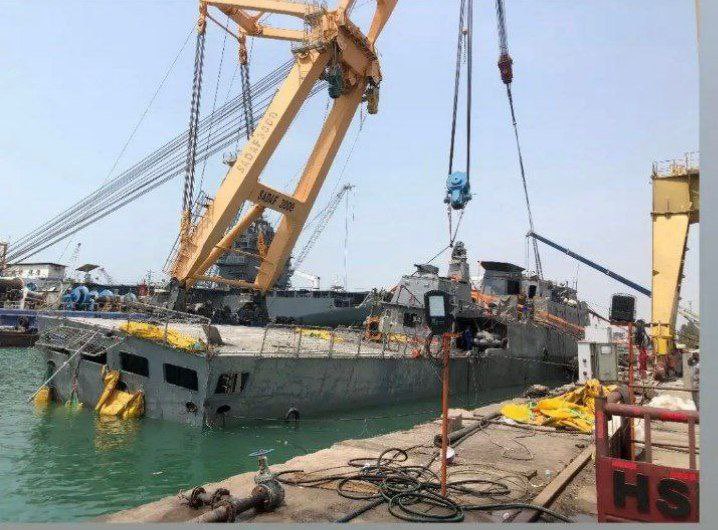After a painstaking salvage operation spanning several days, Iran has reportedly succeeded in retrieving its Moudge class frigate Sahand (IRIS-74) from the depths where it sank earlier this month.
An image circulating on the internet shows the frigate being lifted out of the water by a massive crane. The operation, said to have taken place on the night of July 19, 2024, utilized a specialized floating crane from the Iran Shipbuilding and Offshore Industries Complex (ISOICO) and involved skilled engineering units.
Earlier, a photograph had emerged on July 18 showing the frigate partially raised, with only the uppermost portion visible above the waterline. This image highlighted the extensive efforts required to complete the operation.
The IRIS Sahand had capsized and sunk in its home port of Bandar Abbas on July 7, 2024. Initial observations showed the frigate tilted onto its port side, with only a portion of the hull and sonar dome above the surface. Despite attempts to stabilize the vessel, it fully sank the following day after the rope securing it broke.

The Iranian Navy attributed the incident to the ship losing its balance due to water ingress while undergoing repairs at the wharf. However, speculation has arisen regarding the vessel’s stability issues, with open-source intelligence suggesting that recent upgrades may have contributed to the problem.
The Sahand participated in Russia’s annual naval parade in St. Petersburg in 2021 without reported issues. After it returned to Iran, it was subsequently fitted with additional anti-ship missile launchers, surface-to-air missile launchers, and new radar systems. These modifications might have impacted the frigate’s stability, though this remains unconfirmed.
As the Iranian Navy begins the process of evaluating the condition of the Sahand, the focus will now shift to assessing the extent of the damage and determining the feasibility of repairs.
The successful salvage marks a critical step in restoring the operational capabilities of the Moudge-class frigate.
The Iranian Shipbuilding & Offshore Industries Complex (ISOICO) has expressed optimism that the Sahand might be repairable. However, saltwater immersion poses a significant threat to a warship’s electronic systems, including controls, weapons, and automation systems.
The Norwegian frigate Helge Ingstad, which sank partially in 2018, faced similar challenges; although it was recovered, it was ultimately scrapped due to the prohibitive cost of replacing saltwater-damaged systems.
Iranian Moudge-Class Frigate Sahand (IRIS-74)
The Sahand is one of Iran’s newer indigenous frigates, modeled on the British-designed Vosper Mark 5. The British-designed vessels were originally supplied by the UK before the Iranian Revolution
The Moudge-class ships, including the Sahand, represent iterative improvements with different weapon configurations. Sahand’s distinctive sloping sides give it a modern appearance and may also help reduce its radar signature, making it less detectable to enemy sensors.
Re-launched in late 2018, the 315-foot-long, 1,300-ton Sahand is named after an earlier Iranian warship sunk by US forces during a naval clash in 1988. The original IRIS Sahand (formerly Faramarz, F-74), a British Alvand-class frigate, was destroyed by the US Navy in retaliation for the mining of the USS Samuel B. Roberts.
Following a series of American strikes, the Sahand (F-74) suffered a catastrophic magazine explosion and sank, resulting in the loss of 45 crew members.

Nonetheless, after the new Sahand was launched in 2018, Iranian media boasted that it could operate for approximately five months without needing to refuel. The vessel was equipped with a helicopter pad, advanced radar, and surface-to-surface and surface-to-air missiles.
Since its launch, the Sahand has been upgraded with a new AESA radar, 4-8 medium-range air-defense missiles, and double the number of anti-ship missiles, potentially raising its center of gravity.
These frigates have been deployed by Iran to the Red Sea, where they are suspected of supporting the Houthi Movement, which has been attacking merchant ships in the region.
Meanwhile, the Iranian Navy has struggled with similar incidents involving other warships in recent years.
In June 2021, it lost the 680-foot-long Kharg support ship, its largest by tonnage, to a fire that injured 33 crew members. Unlike the Sahand, the Kharg was built by the United Kingdom and was destroyed by fire, highlighting the varied risks faced by the Iranian Navy’s fleet.
In January 2018, the Sahand’s sister ship, the 315-foot-long Damavand frigate, considered the navy’s most crucial warship in the Caspian Sea, sank after striking a breakwater at Bandar-e Anzali port during rough seas, killing two crew members.
- Contact the author at ashishmichel(at)gmail.com
- Follow EurAsian Times on Google News




